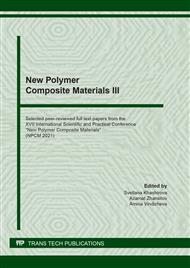[1]
A.D. Macallum // J. Org. Chcm. 1948. V. 13. р. 154.
Google Scholar
[2]
Пат. США 3354129. 1967. С. А. 68. 13598. (1968).
Google Scholar
[3]
Пат. США 3524835. 1970. С. А. 73. 121201. (1970).
Google Scholar
[4]
J.H. Bannock, et al., The influence of polymer purification on the efficiency of poly(3-hexylthiophene): fullerene organic solar cells, Scientific Reports. 6 (2016) 23651.
DOI: 10.1038/srep23651
Google Scholar
[5]
G. Zhao, et al., Efficiency of Polymer Solar Cells Based on poly(3-hexylthiophene) and Indene-C60 Bisadduct by Device Optimization, Adv. Mater. 22 (2010) 4355-4358.
DOI: 10.1002/adma.201001339
Google Scholar
[6]
C.C. Chen, et al., An Efficient Triple-Junction Polymer Solar Cell Having a Power Conversion Efficiency Exceeding, Adv. Mater. 26 (2014) 5670-5677.
DOI: 10.1002/adma.201402072
Google Scholar
[7]
S. Matsumura, N. Kihara, T. Takata, Properties of a few aromatic poly(thioetherketones) as sulfur-containing high-performance polymers, Journal of Applied Polymer Science. 92 (2004) 1869-1847.
DOI: 10.1002/app.20169
Google Scholar
[8]
R.M. Mamkhegov, M.M. Murzakanova, Z.V. Dzhandigova, L.S. Murzamuratova, A.T. Tsurova, S.Yu. Khashirova, Research of the Impact of Catalysts, Temperature and Pressure on Polyphenylenesulfide Synthesis, Key Engineering Materials. 816 (2019) 14-18.
DOI: 10.4028/www.scientific.net/kem.816.14
Google Scholar
[9]
M.М. Murzakanova, T.A. Borukaev, T.A. Mikitaev, Development of an efficient method for polyphenylene sulfide production, Inorganic materials: applied research. 9 (2018) 634-638.
DOI: 10.1134/s2075113318040226
Google Scholar
[10]
Z.Y. Wang, A.S. Hay, Poly(arylene sulphide)s from masked bisthiophenols, Polymer. 33 (1992) 1778-1779.
DOI: 10.1016/0032-3861(92)91083-e
Google Scholar
[11]
L.Wang, Sh. Zhang, X. Xu, Catalytic activity of metal acetate in transesterification of diphenyl carbonate and 1,4-butyldiol, 3rd International Conference on Material, Mechanical and Manufacturing Engineering. (2015) 367-370.
DOI: 10.2991/ic3me-15.2015.71
Google Scholar
[12]
W.K. Carrington, C.E. Handlovits, R.W. Lenz, Method for preparing linear polyarylene sulfide, Patent USA № 3274165 (1966).
Google Scholar
[13]
A.D. Macallum, J. Org. Chcm. 13 (1948) 154.
Google Scholar
[14]
M. Kim, J. Lee, H.Y. Roh, D. Kim, J. Byeon, J. Park, Effect of covalent functionalization of MWCNTs on the thermal properties and non-isothermal crystallization behaviors of PPS composites, Polymers. 9 (2017) 460.
DOI: 10.3390/polym9100460
Google Scholar


